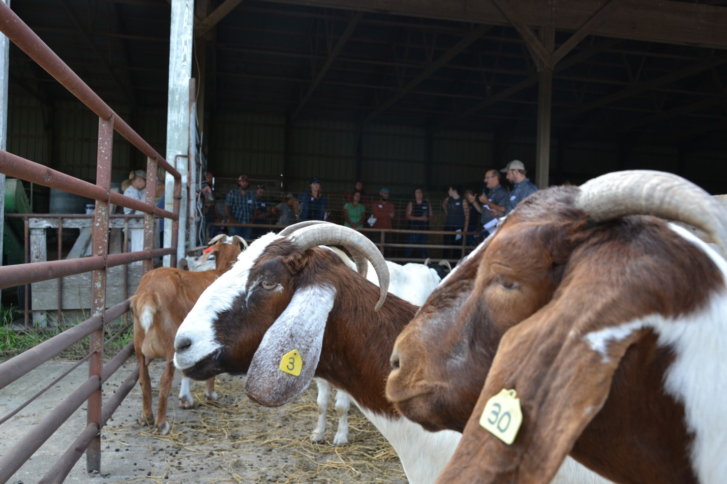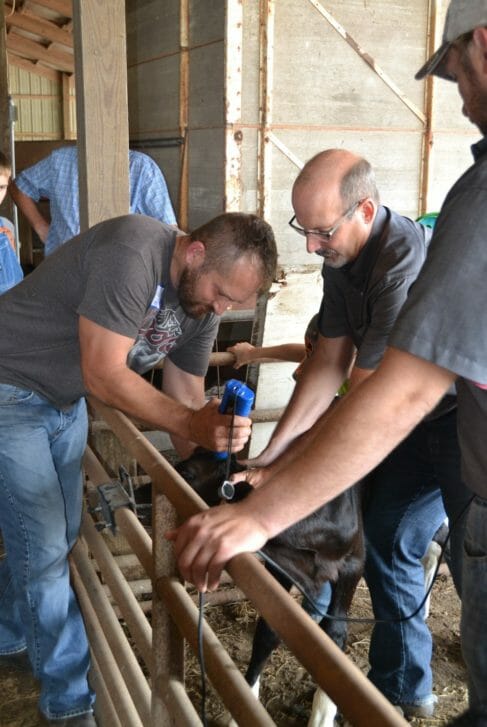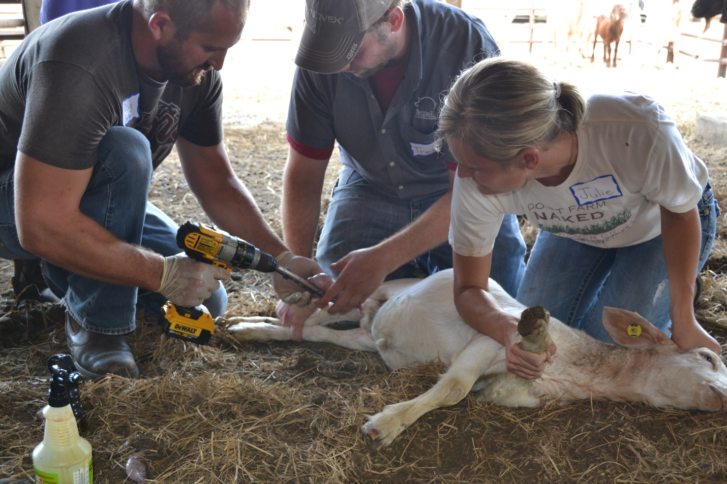Field Day Recap: Hands-On Livestock Care With a Veterinarian
Veterinarians Kurt Van Hulzen and Trevor Schwartz of Suidae Health and Production, with veterinary assistant, Julie Wheelock of Lake City Veterinary Clinic, led a hands-on field day with 34 attendees on September 14. Attendees came to brush up on their animal care skills. The two veterinarians gave an overview of different husbandry practices from dehorning calves, castrating and how to perform a necropsy (an animal autopsy).
At-Home Calf Care
Kurt and Trevor advise dehorning calves at 5-7 weeks of age as their horn buds begin to protrude. At this age, dehorning is less stressful on the calf and is easier to accomplish than when they get older. Electric dehorners like, Buddex and HornStop, kill cells at the base of the horn which keeps the horn from growing. The easiest way to prevent horns is to select polled bulls to pass that genetic trait on to their offspring.
Bloat is a common issue to watch for in any age of cattle. Calves are especially prone to bloat, which is caused by excessive gas created in the abomasum. Clover-rich pastures can cause bloat, so calves will need to be gradually transitioned onto pastures containing lots of clover. Probiotics can help treat symptoms. Another form of bloat creates excess froth and is due to grain overload. In this case, the calf will need to be tubed. The tube goes through the esophagus to the rumen, making sure not to accidentally insert the tube in the trachea (windpipe). “Use the size of your thumb to determine the size of a hose you should use, and make sure the hose has no sharp edges,” advised Kurt.
Like humans, livestock will run a fever when they are sick. The normal temperature range for calves is 100.5-101.5 ⷪ F and 102-103 ⷪ F on a hot day. A rectal thermometer is recommended. Along with temperature, other things to observe are coughing, scours (diarrhea) and droopy ears.
For vaccines, Kurt and Trevor advise giving injections in the front of the shoulder to avoid scar tissue development that negatively affects meat quality. Subcutaneous (sub-q) shots are given under the skin and intramuscular (IM) shots are given in the muscle of the neck. Review a list of needle sizes and their proper uses, below. At birth, calves are given several vaccines to prevent illnesses like scours and blackleg. Consult with a veterinarian to develop a vaccination protocol for your herd. To see which type of needles to use and when check this list of possible uses for IDEAL needles
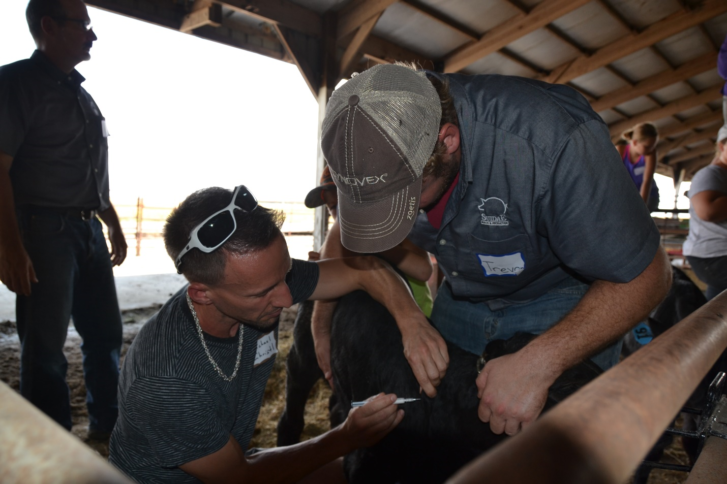
Trevor helps a field day attendee administer a vaccine on a calf.
To castrate calves Kurt and Trevor demonstrated the banding method, using an elastic band placed above both testicles, which will then atrophy and fall off after about ten days.
Pink eye is another health issue to watch for with calves, but if caught early it can be treated with tetracycline (an antibiotic). In order to prevent and treat pink eye:
- Decrease stock density
- Increase rotations through pasture to decrease fly pressure
- If seen, cover the eye with a patch to keep flies and sun away (Glue patches are recommended over stitching the eye up). The antibodies in the secretion from infection will help heal conjunctivitis.
Pig Care
For Kurt and Trevor, who are both swine specialists, highlighted how pigs have a quick generation interval allowing farmers to generate favorable cash flow. When pigs are kept healthy, they are extremely efficient in putting on weight (most efficient are fish and chickens). At 30 days of age and around 20 pounds, weaned pigs are ready for the outdoors. To determine the weight of your pigs and other livestock, use this guide on estimating animal weight. If pigs are raised on concrete and will not have access to dirt, Kurt and Trevor recommend an iron shot.
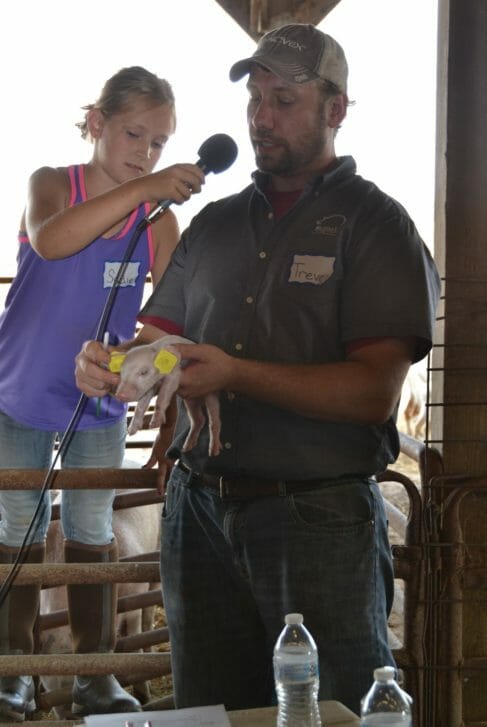
Trevor instructs field day attendees on how to prepare for castrating pigs.
Many illnesses that inflict pigs are caused by airborne transmission, and due to the high density of pigs in Iowa, farmers deal with many airborne diseases. “What a pig needs to thrive is good air, good water and good feed,” says Kurt. On-farm biosecurity is also essential. “The biggest thing you can do to lessen the spread of disease is change your clothes and wash your hands,” says Trevor.
When castrating pigs, make slits with a scalpel, pinch out both testicles, then spray with iodine. The industry standard is to castrate pigs at seven days or younger.
Prolapses are an issue dealt with by many livestock farmers. “Prolapses are when an organ that should be inside the body cavity isn’t,” explained Kurt. Common causes are straining while farrowing, genetic predisposition and piling in bedding. Prolapses present themselves in these ways:
- Vaginal: Roll the prolapse back into the body cavity then use an X suture to stitch it up. Use cotton to stitch and remove it just before calving and lambing.
- Rectal: Use a purse string suture
- Uterine: This is the most difficult prolapse to deal with. Use gravity to help put the uterus back inside the body. For small animals, such as a sheep, hang with back legs over a gate to perform this procedure. Put sugar on a prolapsed organ to draw out water and shrink swelling.
The normal temperature of pigs varies between 100-102 ⷪ F; sick pigs will run between 102.5-106 ⷪ F. Common signs of illness to check for are:
- Panting/labored breathing
- Droopiness
- Foaming at the mouth
- Diarrhea
Goat Care
For goats, internal parasites can cause serious issues. Kurt and Trevor recommend rotating dewormers annually; quarterly if there are bad parasite problems in the herd. To decrease parasite pressure, Trevor suggested culling the bottom 10% of your herd every year.
One method of castrating bucks is to cut the bottom third of the scrotum, and then pull the testicles, releasing the muscle that holds them in place. To cut, use a small disposable scalpel and apply steady pressure. Trevor then used a Henderson Castrating Tool, which uses twisting action to sever the cord that attaches testicles to the body.
On-farm necropsy
The first step in dealing with any herd health challenge is diagnosing the problem. The next step is contacting your veterinarian to communicate the health issues you are seeing.
Necropsies are a common diagnostic tool in veterinary medicine, which can be done on- farm and without a vet. Necropsies play an important role investigating what could have contributed to the death of the animal. During a necropsy, the animal’s body is opened to examine and identify abnormalities within the respiratory or digestive systems. To help your veterinarian understand the health issues you are seeing it is helpful to take photos of the chest cavity, small and large intestines, stomach contents, liver, and the spleen. These photos can then be sent to your vet and diagnosis can be determined over the phone; this is commonly referred to as “telemedicine.”
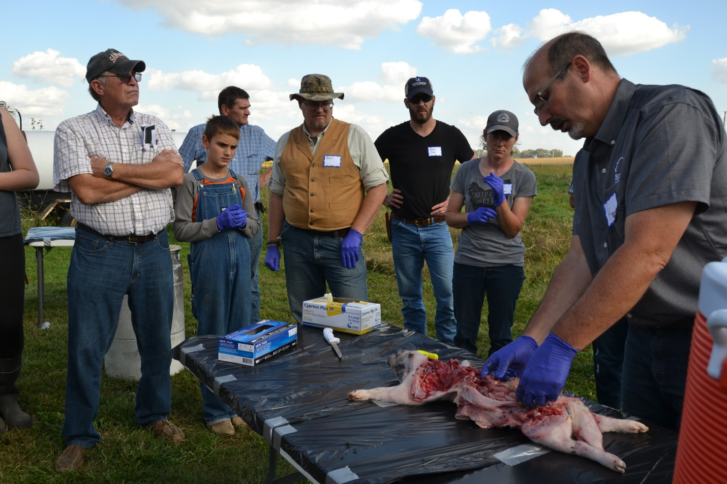
Kurt demonstrated to field day attendees the steps to conduct a necropsy and which bodily signs to observe.
“Cut off a piece of lung, if it floats the pig was still able to breath before it died, but if it sinks that shows that the pig was not breathing when it died,” explained Kurt. “If the lung is hard to the touch, it indicates the pig had pneumonia. The edges of the liver should be knife-edge sharp. If rounded, a disease caused swelling in the liver.”
“When examining the stomach, look for ulcers; they can cause fatal blood clots. Also, it is important to see if the pig had been eating. If the pig’s stomach is empty, the pig went off feed, meaning it was likely feeling ill,” continued Kurt. Also, evaluate intestines to see if blood is present and the consistency of feces.
Refreshing on animal health care skills help to make the best use of you and your veterinarian’s time when dealing with sick livestock.
Thank you to Dr. Kurt Van Hulzen, Dr. Trevor Schwartz, and Julie for presenting such a practical, hands-on field day!

